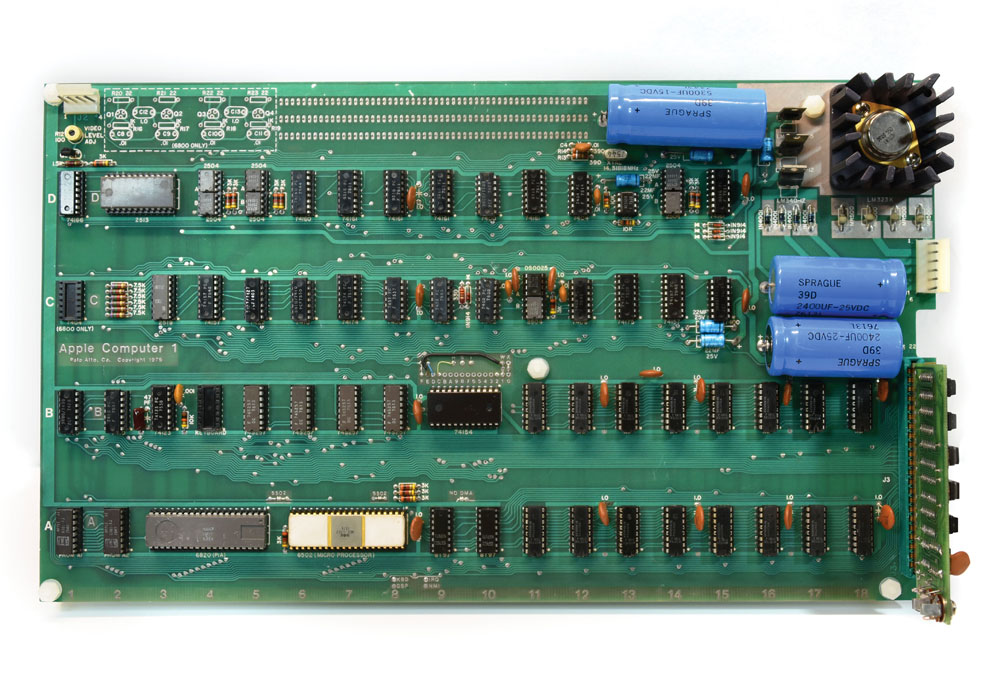Original Apple-1 computer. Offered by RR Auction in the Sept. 25, 2018 live auction event, Remarkable Rarities.
When Steve Jobs and Steve Wozniak partnered in 1976 to create their start-up, Apple Computer, a revolution was on the horizon. And for many early adopters who brought Apple technology into their homes, those products are now pulling in thousands. Apple-1 computers in particular have been highly sought after, and in no small part due to scarcity.
According to Fortune, approximately 50 Apple-1 models still exist, some in museums worldwide, like the Smithsonian Museum of Art and the Computer History Museum. Furthermore, Fortune notes that previous Apple-1 computers have sold at auction for up to $905,000.
As part of one computer sold by RR Auction in 2018, that set includes:
• original Apple-1 board
• original Apple Cassette Interface (ACI)
• original Apple-1 Operation Manual
• two original Apple Cassette Interface manuals
• a period surplus ASCII keyboard
• a period ‘open frame’ Sanyo 4205 video monitor
• a new period-style power supply with original Apple-1 power cable and connector
• period cassette interface cables
This Apple-1 computer was restored to its original, operational state in June 2018 by Apple-1 expert Corey Cohen. In a comprehensive test, the system was operated without fault for approximately eight hours. He evaluated the condition of the unit as 8.5/10.
NPR’s Todd Bookman interviewed Cohen on the eve of the company’s latest iPhone roll-out, noting that “before Apple was a trillion-dollar company, before its phones and laptops came to dominate the tech industry, it was just a California startup working out of a garage.” NPR goes on to quote Steve Wozniak as saying “The summer that I built the Apple-1 computer, I was totally aware that a revolution was close to starting,” in a Bloomberg News story in 2014.
In a statement to Fox Business, RR Auction’s Executive Vice President Bobby Livingston states that owning a fully functional, original Apple-1 computer (also commonly known as the Apple I, or Apple Computer 1), complete with all components and accessories “is like holding the blueprint of a $3 trillion legacy in your hands.”
Considered “the guy” for expert Apple-1 restoration, Cohen spent considerable time demonstrating proof of life for RR Auction on the artifact. But in addition to its functionality, many passionate collectors respect its aesthetics as well. “From a layout perspective, it is considered a piece of art,” Cohen told NPR. “Many people hang these on the wall.”
Cohen produced the proof of life video below for RR Auction; note the amusing juxtaposition of the 1976 original Apple-1 computer and the iPod used to confirm functionality.
The NPR segment also included commentary from Dag Spicer, senior curator for the Computer History Museum. “The Apple-1 is so iconic of that era, of the garage era of Silicon Valley, that I think there is almost no other object that really encapsulates what it does culturally and technologically,” Spicer told NPR, noting that the museum’s own Apple-1 computer is one of their most popular pieces.
The idea was originally conceived by Steve Jobs and Steve ‘Woz’ Wozniak as a bare circuit board to be sold as a kit and completed by electronics hobbyists, their initial market being Palo Alto’s Homebrew Computer Club. Seeking a larger audience, Jobs approached Paul Terrell, owner of The Byte Shop in Mountain View, California, one of the first personal computer stores in the world. Aiming to elevate the computer beyond the realm of the hobbyist, Terrell agreed to purchase 50 Apple-1 computers, but only if they were fully assembled. The Apple-1 thus became one of the first ‘personal’ computers which did not require soldering by the end user. All together, over a span of about ten months, Jobs and Wozniak produced about 200 Apple-1 computers and sold 175 of them.
The later production ‘Byte Shop’-style of the Apple-1 sold in 2018 is indicated by discrete component dates which match other known Apple-1 boards of similar vintage, assembled and sold by Apple in the fall of 1976 and early 1977. On the left side, the board is marked: “Apple Computer 1, Palo Alto, Ca. Copyright 1976.” Unlike many of the known Apple-1 boards, this unit has not had any modifications to the physical board, and the prototype area is clean and unused. The Apple-1 is not only a marvel of early computing ingenuity, but the product that launched what is today one of the most valuable and successful companies in the world.
Check out more Apple-1s from RR Auction’s previous sales here. RR holds auctions relating to Apple Computer and Steve Jobs twice a year, and you can consign your vintage tech (including your Apple-1s) by filling out the form down below. ↓

